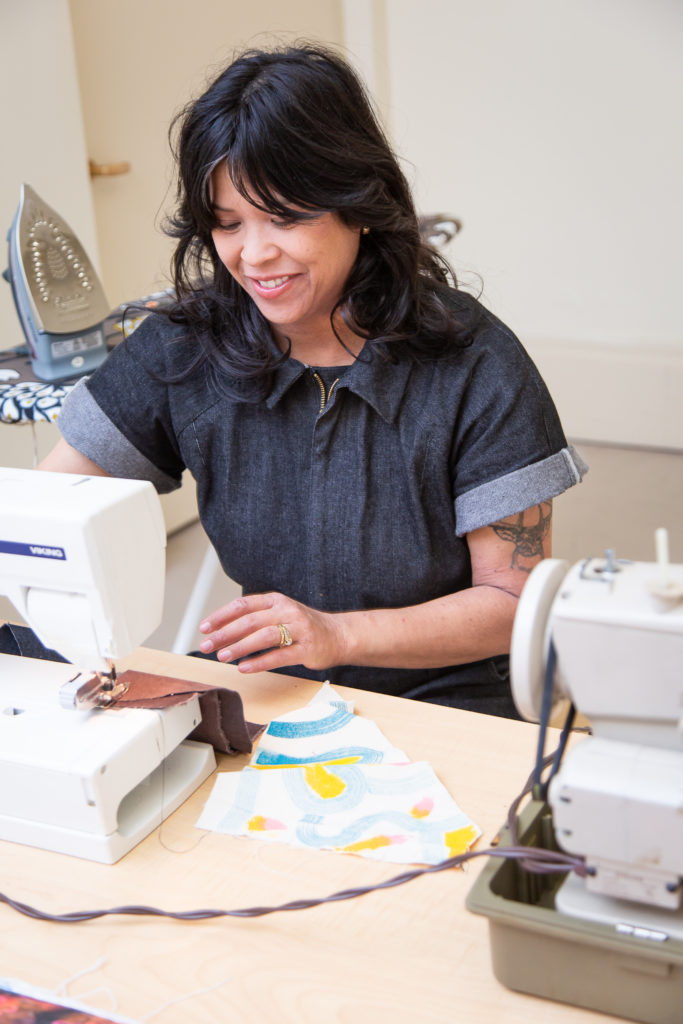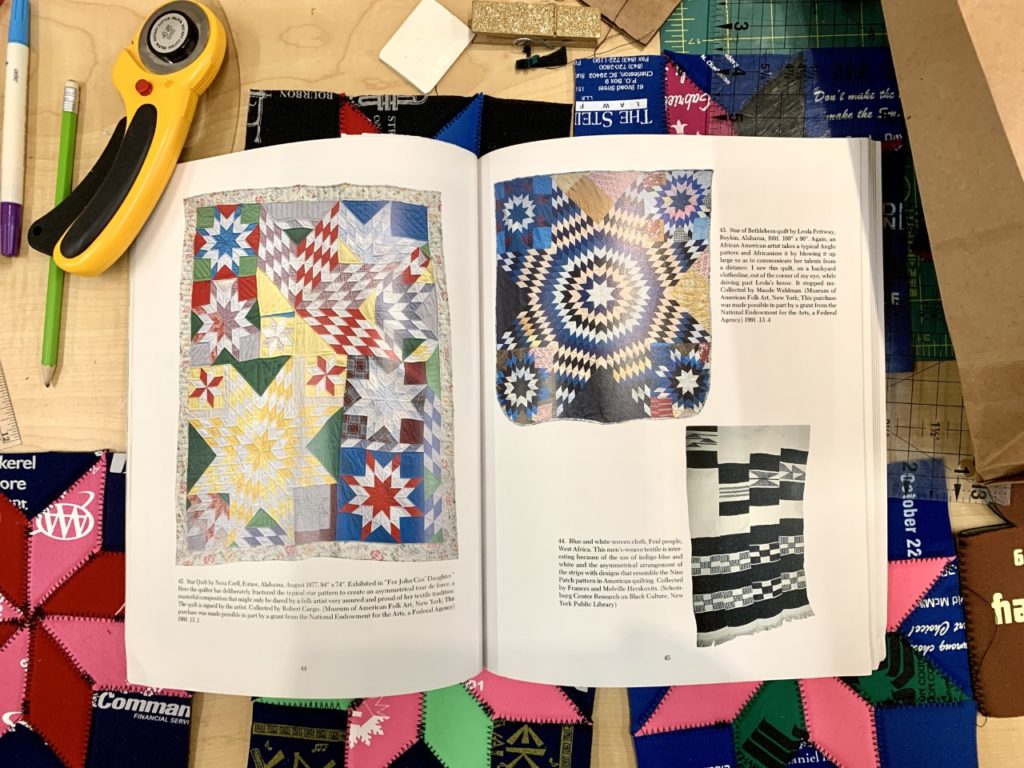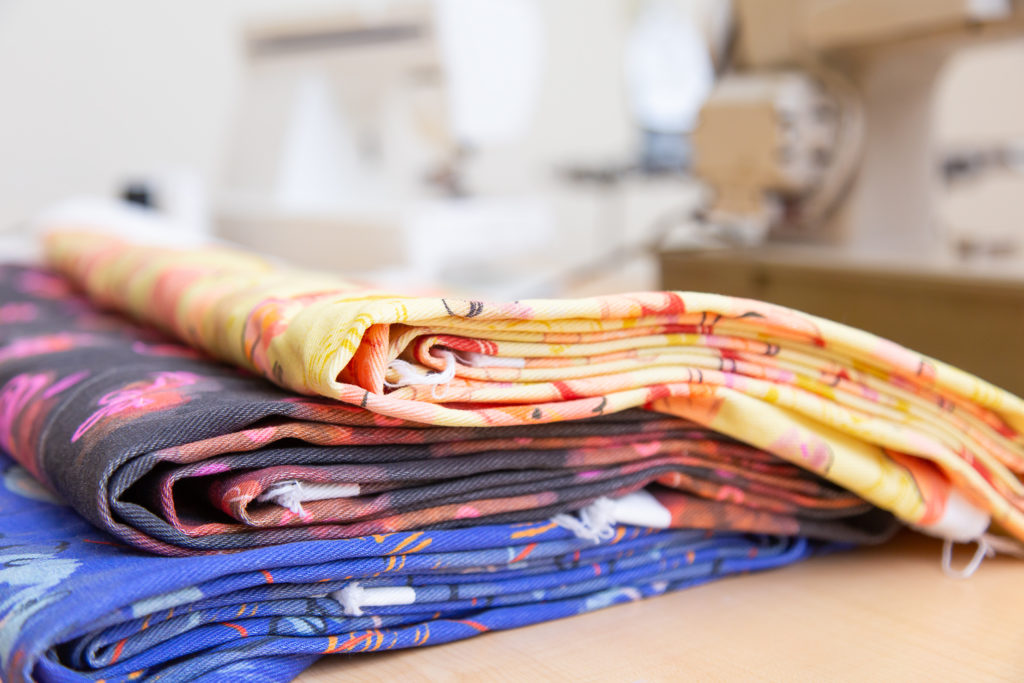Interviewed by Erin Glaze, Director of Contemporary Initiatives and Public Engagement
Camela Guevara is a fiber artist and painter residing in Charleston, SC. She creates handmade monuments to unsung labor. Employing traditional techniques of the past and re-contextualizing everyday objects, the artist subverts capitalistic ideals of consumption with a can-do attitude and self-reliance. During her residency at the Gibbes, May 3 – 31, 2021, Camela merged her two practices of sewing and painting while engaging Museum visitors by asking them to rethink their connection to cloth. Below, Camela shares her background, the impetus behind her work, and how art can shape life outside the studio and gallery walls.
Erin Glaze [EG]: Hello Camela, it was wonderful having you in the studio during the month of May. We decided a nice way to conclude the residency would be a Q & A. Let’s dive into some questions so we may learn even more about you, your artistic practice, and your influences.
What role do you feel artists have in society?
Camela Guevara [CG]: Artists have the role of truth-telling and sometimes that means addressing things that people do not want to be confronted with.
[EG]: Is your work informed by certain concepts or themes from your childhood, where you lived or were raised? How does this impact how you see the world and create art?
[CG]: Yes, I try to not let that sense of play fade away. I still approach artmaking like an experiment and ask what I can make with what I have at hand. My brother, Conrad, and I were always thinking outside of what constitutes an art supply growing up…that and my dad being very frugal [laughter] forced us to be creative with what we had. I am grateful for this now as I live in the mindset of “abundance,” I have everything that I need.
Also, we moved around a lot, my dad was in the Air Force, and so art for me is where I feel most confident. I was very shy growing up and at times felt “othered.” Art has always been a feel good space for me, my home. Art has also helped me feel connected to other people.
[EG]: How has your practice changed over time?
[CG]: Well, I also feel that artists play the role of scientist in their studios. So, over time you are always pushing what “work” looks like. This residency has revealed how important and beneficial it is for my studio practice to get up and create before becoming encumbered by the stresses of the day. This change is also a reminder that this is my vocation and it deserves to be the top priority.
[EG]: What work do you most enjoy doing? What jobs have you done other than being an artist?
[CG]: Probably work that I do not have a requirement to do [laughs]. I most enjoy focusing on that.
I worked in an alterations shop in college which is where I learned the “right” ways to sew. From there I worked in small-scale manufacturing, producing pieces for local designers. This included housewares, bags, clothing, upcycled clothing…even dog bow ties.
[EG]: Does your focus on “invisible labor” come from those work experiences?
[CG]: Definitely, working in alterations opened my eyes to how much work it is to construct a garment. A lot of times you are taking something apart and working backwards to fix it or make it right for the person. Very highly skilled labor is required to do this work and I feel it is hidden away…for many reasons, including fast-fashion being produced overseas. It raises questions like: are they fairly compensated? Who is making these pieces? Are they treated well? How can we uphold the value of this work if we expect as a society to pay the lowest amount possible? We’d always joke that women doing alterations for a long time were just going to be grumpy. It is underappreciated work that is like a puzzle. You also have to be skilled with the mechanics of the gear required.
[EG]: Speaking of gear required, do you have a favorite tool?

[CG]: I love sewing machines. They are puzzles themselves.
[EG]: Living in Charleston, how do you connect with the art world outside of your regular environment?
[CG]: I am really grateful for my artist community that I have gotten to know during the pandemic through Artist’s U. It’s an organization I really love. We had weekly meetings called SHIFT where we would check in and discuss shifting our studio practice and homes and lives to be present during this moment and still create. I was able to meet people from all over the state during this time. It is great to see what is being made in the upstate and the midlands. It makes me feel more connected to my state as a whole. The breadth of creativity happening in South Carolina is great – and certain areas are more dominant in performance art like music and dance, which was nice to become familiar with other practices.
[EG]: It is nice to learn ways to connect with other artists outside of just social media. You can learn more about Artist’s U here: http://www.artistsu.org/south-carolina
[EG]: What art do you most identify with? Do you have a favorite artwork?
[CG]: Textiles, quilts, really any fiber works. I love the sensitivity associated with this medium and how sculptural it can be. Right now, my favorite work is “Star Quilt” by Nora Essel, of Alabama. I actually saw this quilt here at the Gibbes prior to the renovation. There’s something very freestyle about this work. I am glad that I got to see this piece in person. I recently acquired the book Signs and Symbols: African Images in African-American Quilts by Maude Southwell Wahlman, which features this quilt along with tons of other beautiful quilts and an interview with Nora. It is just a nice coincidence to be here at the Gibbes while this piece is such an influence.

[EG]: Is the artistic life lonely? What do you do to counteract it?
[CG]: It is kinda lonely, sometimes. My childish sense of wonder can be isolating at times because everyone around me is tackling “grown-up” topics and maybe my work can look frivolous to others…which sometimes gets the response of “oh, my child can do that,” and so yes, I feel artists give up a lot to create work they want to create and people who work outside of the arts can belittle it at times, not looking at it as a true vocation. Also, being an Asian and Latinx woman, there is a lack of representation of presenting work in a professional setting. It is important to see work by people other than white males who dominate our institutions. And, historically, we work even harder to gain that representation, so instead of spending time with friends or doing leisurely things, you have to make time to go to the studio on top of everything else, which can be isolating at times. But, thankfully I have a supportive partner who encourages me to create.
On a positive note, I am continually inspired by the strong tradition of art-making that has taken place for centuries and humans have always had the drive to do this work, which is important.
[EG]: Speaking of the importance of art, do you think art should be government-funded?
[CG]: Yes, I am very grateful for growing up and attending public schools in South Carolina where I had art every year. I feel like that is not typical for everyone. Having art class throughout my youth gave me space where I could grow my confidence. A sense of self-worth. Art can light up people’s lives. It is not “extra,” it is important. Also, artists possess creative problem-solving that can lead the way in innovation for issues like housing, food, climate change, etc. Art adds to the quality of life.
[EG]: What is your dream project?
[CG]: Honestly, my current project is a dream project! Making the jumpsuits, learning surface pattern design, and having it printed on fabric was definitely a dream project and it was able to happen!

[EG]: Who are some artists you’d like to be compared to one day?
[CG]: Georgia O’Keefe, a lot of people don’t know that she was a very talented seamstress with a particular style that wasn’t the norm for women at the time. Her paintings are also amazing.
And, Andrea Zittel, for the same reason of making her own garments and living within her art. She would make really unique garments that she would wear for a whole season. She takes everyday items and structures, like houses and campers into artful experiments in living, which is very inspiring.
[EG]: What’s the best piece of advice you’ve been given?
[CG]: Probably what I learned through Andrew at Artist’s U regarding negotiating payment for a job or work. He said to let the other person lead instead of naming your own price. This has helped me immensely so I do not sell myself short. It is best to ask “what is your budget?” before proceeding. Placing a value on art and services can be a daunting task.
[EG]: What memorable responses have you had to your work?
[CG]: I received a lot of good feedback here about the koozie quilts. People really resonate with the re-use of the freebie item that people have random drawers full of. I think the graphic nature of the koozie quilts is fun and gets people thinking about what other random things could be used as art materials.
[EG]: What did you enjoy most about being an artist in residence at the Gibbes Museum of Art?
[CG]: I enjoyed coming to work daily in a beautiful environment where I could spread out and get creative!
You can follow Camela Guevara’s work at www.camelaguevara.com and on Instagram @camelaguevara.
Top image: Portrait of Camela Guevara, Studio One at the Gibbes Museum of Art, 2021, MCG Photography
Posted June 15, 2021

